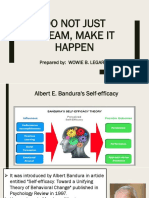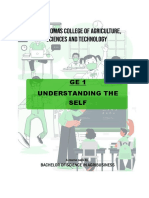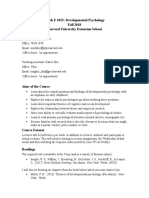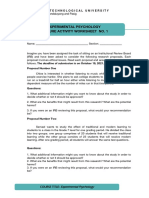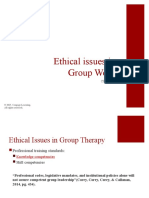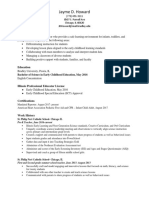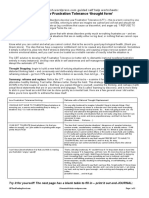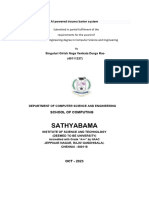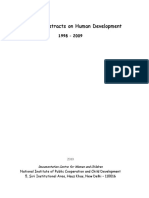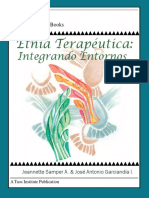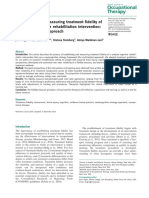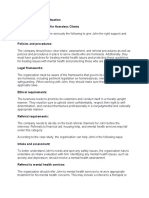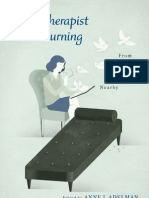THEORIES ON PERSONALITY DEVELOPMENT
OUTLINE
I Personality
II Sigmund Freud
A Psychoanalysis
B Defense Mechanism
C Stages of Personality Development
D Psychosexual Stages
III 4 types of Personality Theories
A Psychodynamic Personality
B Humanistic Personality Theories
C Trait Personality Theories
D Social Cognitive (Learning) Approaches to Personality
Theories
THEORIES ON PERSONALITY DEVELOPMENT
PSYCHOANALYSIS: FREUD’S THEPRY OF
PERSONALITY PERSONALITY
• refers to the relatively enduring characteristics that
• Freud’s theory suggest that personality is composed of the
differentiate one person from another and that lead people
id, the ego, and the superego
to act in a consistent and predictable manner, both in
• ID: the unorganized, inborn part of personality whose
different situations and over extended periods of time.
purpose is to immediately reduce tensions relating to
• defined as: the enduring or lasting patterns of behavior and
hunger, sex, aggression, and other primitive impulses.
thought (across time and situation).
• EGO. restrains instinctual energy in order to maintain the
safety of the individual and to help the person to be a
FOUR MAJOR PERSPECTIVES ON PERSONALITY
member of society.
• Psychoanalytic - unconscious motivations • SUPEREGO the rights and wrongs of society and consists
• Trait - specific dimensions of personality of the conscience and the ego-ideal.
• Humanistic - inner capacity for growth
• Social-Cognitive - influence of environment FREUD AND PERSONALITY STRUCTURE
SIGMUND FREUD Id- energy constantly striving to satisfy basic drives
• What is the structure and development of personality, PLEASURE PRINCIPLE
according to Sigmund Freud and his successors
(i.e.,psychoanalysts)
• According to psychoanalysts, much of behavior is caused Ego - seeks to gratify the Id in realistic ways
by parts of personality which are found in the unconscious Reality Principle
and of which we are unaware. unaware
• Freud’s 3 levels of awareness/consciousness:
o the conscious mind
Super Ego - voice of
o the preconscious mind;
conscience that focuses
o the unconscious mind.
on how we ought to
behave
PSYCHOANALYSIS: THE UNCONSCIOUS
FREUD’S THEORY: “THE ID
• The id uses the most primitive of thinking process.
• Basic biological urges (e.g., hunger, self-protection).
• The id operates on the Pleasure Principle.
o Seeks pleasure and avoids pain:“I want what I want
NOW!” NOW!
• The id operates completely at an unconscious level.
o No direct contact with reality.
• The id has 2 major instincts:
• Eros: life instinct = motivates people to focus on pleasure-
Eros seeking tendencies (e.g., sexual urges).
o Thanatos: death instinct = motivates people to use
aggressive Thanatos urges to destroy.
CANLAS| 3BSN 1
� TRANS: Theories on Personality Development
• The energy for the id’s instincts comes from the libido, (the REGRESSION
libido energy storehouse). • acting in ways characteristic of earlier life stages/earlier
stage of personality.
FREUD’S THEORY: “THE EGO” o A young adult, anxious on a trip to his parents/ home,
• The ego consists of a conscious faculty for perceiving and sits in the corner reading comic books, as he often did
dealing intelligently with reality. in grade school.
• The ego acts as a mediator between the id and the REACTION FORMATION
superego.
• replacing an anxiety-producing formation feeling with its
• The ego is partly conscious.
exact opposite, typically going overboard; repressed
• Deals with the demands of reality. thoughts appear as mirror opposites.
• Makes rational decisions. o A man who is anxious about his interest in gay men
• The ego serves the ID: begins dating women several times a week.
o The rational part of personality that maintains contact RATIONALIZATION
with reality.
▪ Governed by ‘Reality Principle’ • creating false but believable excuses to justify inappropriate
▪ “What consequences are there to my behavior?” behavior; real motive for behavior is not accepted by ego.
• The ego is the Executive of the personality o A student cheats on an exam, explaining that cheating
o The ego controls higher mental processes. is legitimate on an unfair examination
▪ Reasoning, problem solving. DENIAL
o The ego uses these higher mental processes to help • claiming and believing that something which is actually true
satisfy the urges of the ID. is false.
o A person disbelieves that she is age, asserting that “I
FREUD’S THEORY: “THE SUPEREGO” am not getting older.”
• Superego the moral part of personality. DISPLACEMENT
o Internalized rules of parents and society. • redirecting emotional feelings (e.g., anger) to a substitute
o Superego consists of two parts: target; involves directing unacceptable impulses onto a less
▪ Conscience: “notions of right/wrong.” Conscience threatening object/person.
▪ Ideal: “how we ideally like to be.” Ideal o A husband, angry at the way his boss treated him,
o Superego: constrains us from gratifying every impulse screams at his children.
(e.g., murder) because they are immoral, and not o Instead of telling your professor what you really think
because we might get caught. of her, you tailgate and harass a slow driver on your
o Superego: Superego partly conscious, partly way home from school.
unconscious. PROJECTION
FREUD’S THEORY OF PERSONALITY • attributing one’s own unacceptable feelings or beliefs to
others; perceiving the external world in terms of one’s own
• The id, the ego, and the superego are continually in conflict personal conflicts.
with one another. • An employee at a store, tempted to steal some
• This conflict generates anxiety. anxiety merchandise, suspects that other employees are stealing
• If the ego did not effectively handle the resulting anxiety, SUBLIMATION
people would be so overwhelmed with anxiety that they
would not be able to carry on with the tasks of everyday • substitute socially acceptable behavior for unacceptable
living. impulses.
• The ego tries to control anxiety (i.e., to reduce anxiety) o Playing video games instead of getting in a fight.
through the use of ego defense mechanisms. Mechanisms
STAGES OF PERSONALITY DEVELOPMENT
DEFENSE MECHANISMS • Freud’s psychoanalytic theory of personality suggests that
• When the inner war gets out of hand, the result is Anxiety personality develops through a series of stages, each of
which is associated with a major stages biological function.
• Ego protects itself via Defense Mechanisms
• More specifically, Freud theorized that as people age, they
• Defense Mechanisms reduce/redirect anxiety by distorting
pass through several systematic stages of psychosexual
reality.
development in their personality.
EGO DEFENSE MECHANISMS
PSYCHOSEXUAL STAGES OF DEVELOPMENT ARE
• Definition An defense mechanism is a psychology tendency
that the ego uses to help prevent people from becoming SOURCE OF UNCONSCIOUS CONFLICTS
overwhelmed by any conflict (and resulting anxiety) among • The stages of personality development involve critical
the id, the ego, and the superego. events that occur in every child’s life.
• Defense mechanisms operate at an unconscious level: • At each level, there is a conflict between pleasure and
level reality. reality
o We are not aware of them during the time that we are o The resolution of this conflict determines personality.
actually using them. • At any stage, “a fixation” can occur: occur
o However, we may later become aware of their previous o If needs are either under-gratified or over-gratified, we
operation and use. become fixated at a particular stage. stage
REPRESSION • Each stage also involves an erogenous zone. zone
• pushing unacceptable and anxiety- producing thoughts into o Parts of the body that involve sexual pleasure
the unconscious; involves intentional forgetting but not
consciously done; repressed material can be memories or FREUD AND PERSONALITY DEVELOPMENT
unacceptable impulses. • personality forms during the first few years of life, rooted in
o A rape victim cannot recall the details of the attack. unresolved conflicts of early childhood”
CANLAS| 3BSN 2
� TRANS: Theories on Personality Development
PSYCHOSEXUAL STAGES GENITAL STAGE
• Oral (0-18 mos) - centered on the mouth • When adolescence begin puberty, they enter the 5th stage
• Anal (18-36 mos) - focus on bowel/bladder elim. of psychosexual development.
• Phallic (3-6 yrs) - focus on genitals/“Oedipus Complex” • They develop secondary sexual characteristics (e.g., pubic
(Identification & Gender Identity) hair).
• Latency (6-puberty) - sexuality is dormant Genital (puberty • The onset of the physical sexual characteristics “re-
on) - sexual feelings toward others awakens” people sexual urges, and thus they are no longer
• Strong conflict can fixate an individual at Stages 1,2 or able to successfully repress their sexual desires, impulses,
ORAL STAGE and urges.
• Time period: Birth to 18 months: • They begin searching for a marital mate, with whom they
o Erogenous zone is mouth. can share sex and intimacy.
▪ Gratification through sucking and swallowing.
• Oral fixation has two possible outcomes. 4 TYPES OF PERSONALITY THEORIES:
o Oral receptive personality: personality • 1). Psychodynamic approaches to personality.
o Preoccupied with eating/drinking. • (2). Humanistic approaches to personality.
o Reduce tension through oral activity. • (3). Trait approaches to personality.
▪ eating, drinking, smoking, biting nails • (4). Social Cognitive approaches to personality.
▪ Passive and needy; sensitive to rejection.
o Oral aggressive personality: personality
▪ Hostile and verbally abusive to others. PSYCHODYNAMIC APPROACHES TO
ANAL STAGE OF DEVELOPMENT: PERSONALITY.
• Time period: 1 1/2 to 3 years of age. • Source of information about personality: personality
• Erogenous zone is the anus. o Obtained from expert analyst from people in therapy.
• Conflict surrounds toilet training. • Cause of behavior, thoughts, and feelings: feelings
• Anal fixation has two possible outcomes. o unconscious internal conflict associated with childhood
o Anal retentive personality. experiences.
▪ Stingy, compulsive orderliness, stubborn, o Also, unconscious conflicts between pleasure-seeking
o Anal expulsive personality. impulses and social restraints.
▪ Lack of self -control, messy, careless. • Outlook on humans: humans
o negative.
PHALLIC STAGE OF DEVELOPMENT • Comprehensiveness of theory: theory
o very comprehensive.
• Time period: 3 to 6 years.
• Erogenous zone is the genitals: self-stimulation of the
PSYCHODYNAMIC (PSYCHOANALYTIC) THEORIES
genitals produces pleasure. • Many are called Neo-Freudians. All place less emphasis on
• At age 5 or 6, near the end of the phallic stage, children sex. Neo-Freudians
experience the Oedipal conflict (boys)/the Electra conflict • Carl Jung: Jung
(girls)--a process through which they learn to identify with o Personal vs. Collective Unconscious. Unconscious
the same gender parent by acting as much like that parent o Balance between introversion and extroversion.
as possible. Extroversion
• Oedipus complex (boys) vs Electra complex (girls) • Alfred Adler
o Child is sexually attracted to the other sex parent and o Striving for superiority = motivation to master
wishes to replace the same sex parent. environment.
• Oedipus complex (little boys): o Notion of an Inferiority Complex. Complex
• Castration anxiety: • Karen Horney
o Son believes father knows about his desire for mom. o Personality is Cultural rather than biological. biological
o Fears dad will castrate him.
o Represses his desire and defensively identifies with HUMANISTIC PERSONALITY THEORIES
dad. • Source of information about personality:
• Electra complex (little girls): o obtained from self-reports from the general population
• Penis envy: and people in therapy.
o Daughter is initially attached to mom. • Cause of behavior, thoughts, and feelings
o Shift of attachment occurs when she realizes she lacks o self concepts,
a penis. o self-actualizing tendencies.
o She desires dad whom she sees as a means to obtain o conscious feelings about oneself (based on one’s
a penis substitute (a child). child) previous experiences).
o Represses her desire for dad. • Outlook on humans
o incorporates the values of her mother o positive.
o accepts her inherent “inferiority” in society • Comprehensiveness of theory
o fairly comprehensive
LATENCY PERIOD HUMANISTIC PERSPECTIVE
• During the latency period, little girls and little boys try to • Maslow’s Roger’s Self-Actualizing
socialize only with members of their own gender. • Person-Centered Person Perspective
• Freud posits that children do this so as to help minimize the • “Healthy” rather than “Sick” Individual as greater than the
awareness of “sexuality.” sum of test scores
• Thus, they continue the process of sexual repression that MASLOW AND ROGERS
began in the previous stage (for those who successfully
• Humanistic approach (Third Force):
made it through the Oedipal Complex/Electra Complex).
o Rejected Freud’s pessimistic view of personality.
CANLAS| 3BSN 3
� TRANS: Theories on Personality Development
o Rejected Behaviorist’s mechanistic view. o stable internal characteristics;
o More optimistic/positive about human nature. o some emphasize genetic basis.
o Humans are free and basically good. • Outlook on humans:
o Humans are inner-directed. o neutral - neither positive nor negative.
o Everyone has the potential for healthy growth. • Comprehensiveness of theory:
o Health growth involves Self actualization: o not very comprehensive.
▪ “Be all you can be.”
▪ Given the right environmental conditions, we can TRAIT PERSONALITY THEORIES (CONT): +
reach our full potential. ALLPORT
• Allport Most important personality traits are those that
ROGER’S PERSON-CENTERED PERSPECTIVE reflect our values.
• People are basically good with actualizing tendencies. • Allport suggested that there are 3 kinds of traits:
• Given the right environmental conditions, we will develop to o CARDINAL: a single personality trait that directs
our full potentials most of a cardinal person’s activities (e.g., greed, lust,
• Genuineness, Acceptance, Empathy kindness).
• Self Concept central feature Concept: of personality (+ or ) o CENTRAL: a set of major characteristics that make
up the central core of a person’s personality.
CARL ROGERS o SECONDARY: less important personality traits that
• Self-concept: our image or perception of ourselves (Real do not secondary affect behavior as much as central
Self versus Ideal Self). Self) and cardinal traits do.
• We have a need for positive regard/approval from others.
regard TRAIT PERSONALITY THEORIES (CONT): EYSENCK
o Conditions of worth or conditional positive regard. • Hans Eysenck: found two (2) major trait dimensions:
▪ The conditions under which other people will o introversion versus extroversion (quiet versus
approve of us. sociable).
▪ We change our behavior to obtain approval. o Neuroticism versus emotional stability (moody versus
▪ What we need is: Unconditional positive regard. calm).
Regard
• Anxiety signifies that we are not being true to our ideal self. CATTELL’S THEORY OF PERSONALITY
• Well-adjusted persons: self-concept & experience. • Cattell’s Trait Theory:
• Poorly adjusted person: self-concept & experience. o Distinguished 3 types of traits:
▪ Dynamic.
▪ Ability.
▪ Temperament.
• Also:
o Surface Traits: Less important to personality.
o Source Traits: More important basic underlying traits.
• Cattell identified 16 basic traits.
o He developed the 16PF to measure these traits.
TRAIT PERSONALITY THEORIES (CONT)
• Recently personality theorists have begun to converge on
the view that there are 5 basic personality dimensions:
• 1: emotional stability versus neuroticism:
o calm, secure, self-satisfied VS anxious, insecure, self-
pitying.
• 2: extraversion versus introversion:
o sociable, fun-loving, affectionate VS retiring, sober,
reserved.
• 3: openness versus close-mindedness:
o imaginative, independent VS practical, conforming.
ABRAHAM MASLOW
• 4: agreeableness versus disagreeableness:
• Self-actualization is the culmination of a lifetime of inner- o kind, trusting, helpful VS ruthless, suspicious,
directed growth and improvement: uncooperative
o Challenging ourselves to the fullest. • 5: conscientiousness versus undependable:
o Can you identify a self-actualized individual? o organized, careful, disciplined VS disorganized,
o Characteristics of the self-actualized person careless, impulsive.
▪ Creative and open to new experiences. THE BIG FIVE
▪ Committed to a cause or a higher goal.
▪ Trusting and caring of others, yet not dependent. • Emotional Stability
▪ Have the courage to act on their convictions. o Calm/Anxious
o Secure/Insecure
TRAIT PERSONALITY THEORIES • Extraversion
• Source of information about personality: personality o Sociable/Retiring
o obtained from observation of behavior and o Fun Loving/Sober
questionnaire responses from the general population • Openness
as well as from people in therapy. o Independent/Conforming
• Cause of behavior, thoughts, and feelings: feelings o Imaginative/Practical
• Agreeableness
CANLAS| 3BSN 4
� TRANS: Theories on Personality Development
o Soft-Hearted/Ruthless
o Trusting/Suspicious
• Conscientiousness
o Careful/Careless
o Organized/Disorganized
TRAIT THEORIES OF PERSONALITY: SUMMARY
• Characteristics or typical ways of acting:
o Consistency:
▪ across situations, over time.
o Distinctiveness:
▪ each personality is unique.
• Explain why individuals behave in certain ways.
• How many traits are there, and what are they?
o Not easy to answer; little consensus.
SOCIAL-COGNITIVE (LEARNING) APPROACHES TO
PERSONALITY THEORIES
• Source of information about personality:
o Obtained from experiments, observations of behavior,
and questionnaire responses from the general
population.
• Cause of behavior, thoughts, and feelings
o •reciprocal influence between people (cognitions and
behavior) and their environmental situations, colored
by their perceptions of control.
• Outlook on humans: humans
o neutral: neither positive nor negative.
PERSONAL CONTROL
• Comprehensiveness of theory
o not very comprehensive. • Internal Locus of Control: You pretty much control your
own destiny
• External Locus of Control: Luck, fate and/or powerful
others control your destiny.
• Methods of Study:
o Correlate feelings of control with behavior.
o Experiment by raising/lowering people’s sense of
control and noting the consequences and effects.
SOCIAL LEARNING THEORY
• Bandura: Theoretical origins in behaviorism.
• Emphasizes the role of learning in personality.
o Classical Conditioning.
o Operant Conditioning
o Modeling.
• Instead of studying what’s going on inside the person
(traits), study what is going on outside the person
(environment).
REFERENCES
• How does the environment shape personality?
• Bandura also emphasized the importance of cognition in
personality development. Chabbie, V. (2013, February 22). theories of personality.
• People develop a sense of self-efficacy: self-efficacy Slideshare. Retrieved March 8, 2022, from
o Our beliefs about our ability to achieve goals. https://www.slideshare.net/VivieChabie/1-theories-of-
o Individuals with higher self-efficacy: personality
▪ accept greater challenges.
▪ try harder to meet challenges.
• Bandura also discusses the notion of RECIPROCAL
DETERMINISM:
• The individual and the environment continually influence
one another.
CANLAS| 3BSN 5
�TRANS: Theories on Personality Development
CANLAS| 3BSN 6
